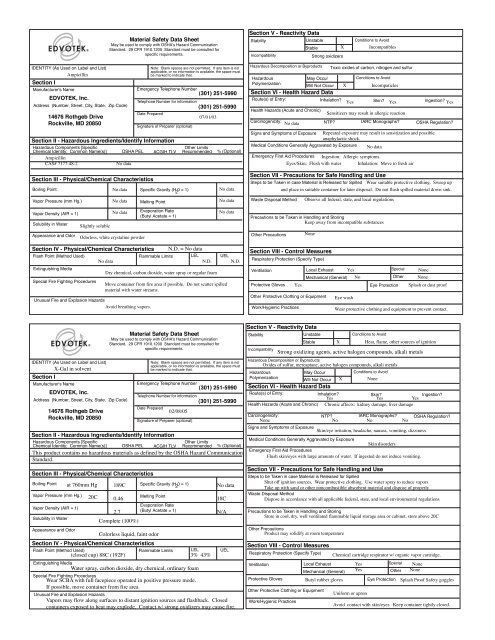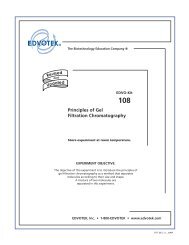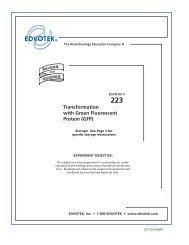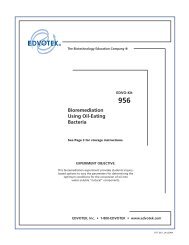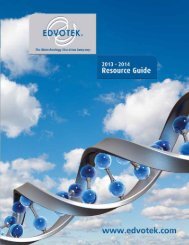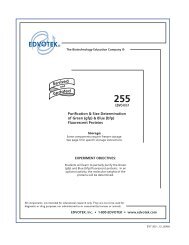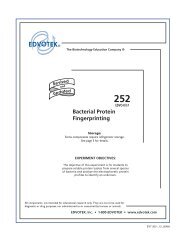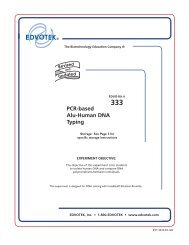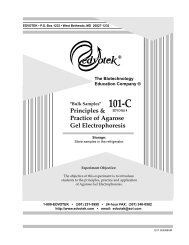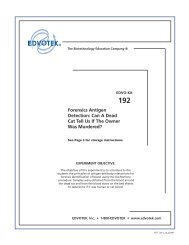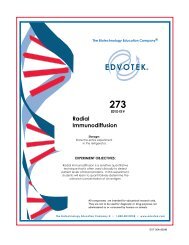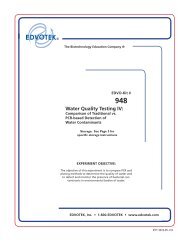221 Transformation of E. coli with pGAL⢠(blue colony) - EDVOTEK
221 Transformation of E. coli with pGAL⢠(blue colony) - EDVOTEK
221 Transformation of E. coli with pGAL⢠(blue colony) - EDVOTEK
- No tags were found...
Create successful ePaper yourself
Turn your PDF publications into a flip-book with our unique Google optimized e-Paper software.
<strong>EDVOTEK</strong>®Material Safety Data SheetMay be used to comply <strong>with</strong> OSHA's Hazard CommunicationStandard. 29 CFR 1910.1200 Standard must be consulted forspecific requirements.Section V - Reactivity DataStabilityUnstableStable XIncompatibilityStrong oxidizersConditions to AvoidIncompatiblesIDENTITY (As Used on Label and List)AmpicillinSection IManufacturer's Name<strong>EDVOTEK</strong>, Inc.Address (Number, Street, City, State, Zip Code)14676 Rothgeb DriveRockville, MD 20850Section II - Hazardous Ingredients/Identify InformationHazardous Components [SpecificChemical Identity; Common Name(s)] OSHA PEL ACGIH TLVAmpicillinCAS# 7177-48-2No dataNote: Blank spaces are not permitted. If any item is notapplicable, or no information is available, the space mustbe marked to indicate that.Emergency Telephone Number(301) 251-5990Telephone Number for information(301) 251-5990Date PreparedSignature <strong>of</strong> Preparer (optional)07/01/03Other LimitsRecommended% (Optional)Hazardous Decomposition or ByproductsHazardousMay OccurConditions to AvoidPolymerizationWill Not Occur XIncompaticlesSection VI - Health Hazard DataRoute(s) <strong>of</strong> Entry: Inhalation?Yes Skin? Yes Ingestion? YesHealth Hazards (Acute and Chronic)Carcinogenicity:No dataNTP? IARC Monographs? OSHA Regulation?Signs and Symptoms <strong>of</strong> ExposureMedical Conditions Generally Aggravated by ExposureToxic oxides <strong>of</strong> carbon, nitrogen and sulfurSensitizers may result in allergic reactionRepeated exposure may result in sensitization and possibleanaphylactic shock.No dataEmergency First Aid Procedures Ingestion: Allergic symptoms.Eyes/Skin: Flush <strong>with</strong> water Inhalation: Move to fresh airSection III - Physical/Chemical CharacteristicsBoiling PointVapor Pressure (mm Hg.)Vapor Density (AIR = 1)Solubility in WaterAppearance and OdorSlightly solubleNo dataNo dataNo dataOdorless, white crystaline powderSpecific Gravity (H 0 = 1)2Melting PointEvaporation Rate(Butyl Acetate = 1)No dataNo dataNo dataSection VII - Precautions for Safe Handling and UseSteps to be Taken in case Material is Released for Spilled Wear suitable protective clothing. Sweep upand place in suitable container for later disposal. Do not flush spilled material down sink.Waste Disposal Method Observe all federal, state, and local regulationsPrecautions to be Taken in Handling and StoringKeep away from incompatible substancesOther Precautions NoneSection IV - Physical/Chemical Characteristics N.D. = No dataFlash Point (Method Used)Flammable Limits LELNo dataN.D.Extinguishing MediaSpecial Fire Fighting ProceduresUnusual Fire and Explosion HazardsAvoid breathing vapors.Dry chemical, carbon dioxide, water spray or regular foamMove container from fire area if possible. Do not scatter spilledmaterial <strong>with</strong> water streams.UELN.D.Section VIII - Control MeasuresRespiratory Protection (Specify Type)Ventilation Local Exhaust YesSpecialMechanical (General) NoOtherProtective Gloves YesEye ProtectionNoneNoneSplash or dust pro<strong>of</strong>Other Protective Clothing or Equipment Eye washWork/Hygienic PracticesWear protective clothing and equipment to prevent contact.IDENTITY (As Used on Label and List)X-Gal in solventSection IManufacturer's NameAddress (Number, Street, City, State, Zip Code)Boiling Point<strong>EDVOTEK</strong>®<strong>EDVOTEK</strong>, Inc.14676 Rothgeb DriveRockville, MD 20850Material Safety Data SheetMay be used to comply <strong>with</strong> OSHA's Hazard CommunicationStandard. 29 CFR 1910.1200 Standard must be consulted forspecific requirements.Note: Blank spaces are not permitted. If any item is notapplicable, or no information is available, the space mustbe marked to indicate that.Emergency Telephone Number(301) 251-5990Telephone Number for information(301) 251-5990Date PreparedSection III - Physical/Chemical CharacteristicsVapor Pressure (mm Hg.)Vapor Density (AIR = 1)Solubility in WaterAppearance and OdorSignature <strong>of</strong> Preparer (optional)Melting PointEvaporation Rate(Butyl Acetate = 1)02/08/05Section II - Hazardous Ingredients/Identify InformationHazardous Components [SpecificOther LimitsChemical Identity; Common Name(s)] OSHA PEL ACGIH TLV Recommended % (Optional)This product contains no hazardous materials as defined by the OSHA Hazard CommunicationStandard.at 760mm Hg20C189C0.462.7Complete (100%)Colorless liquid, faint odorSpecific Gravity (H 0 = 1)2Section IV - Physical/Chemical CharacteristicsFlash Point (Method Used)Flammable Limits LEL(closed cup) 88C (192F) 3% 43%Extinguishing MediaWater spray, carbon dioxide, dry chemical, ordinary foamSpecial Fire Fighting ProceduresWear SCBA <strong>with</strong> full facepiece operated in positive pressure mode.If possible, move container from fire areaNo dataUnusual Fire and Explosion HazardsVapors may flow along surfaces to distant ignition sources and flashback. Closedcontainers exposed to heat may explode. Contact w/ strong oxidizers may cause fire.18CN/AUELSection V - Reactivity DataStabilityIncompatibilityUnstableStableConditions to AvoidHazardous Decomposition or ByproductsOxides <strong>of</strong> sulfur, mercaptane, active halogen compounds, alkali metalsHazardousMay OccurConditions to AvoidPolymerizationWill Not Occur XNoneSection VI - Health Hazard DataRoute(s) <strong>of</strong> Entry: Inhalation? Skin?Yes Yes YesIngestion?Health Hazards (Acute and Chronic) Chronic affects: kidney damage, liver damageCarcinogenicity: NTP? IARC Monographs? OSHA Regulation?None No No NoSigns and Symptoms <strong>of</strong> ExposureSkin/eye irritation, headache, nausea, vomiting, dizzinessMedical Conditions Generally Aggravated by ExposureSkin disordersEmergency First Aid ProceduresFlush skin/eyes <strong>with</strong> large amounts <strong>of</strong> water. If ingested do not induce vomiting.Section VII - Precautions for Safe Handling and UseSteps to be Taken in case Material is Released for SpilledShut <strong>of</strong>f ignition sources. Wear protective clothing. Use water spray to reduce vaporsTake up <strong>with</strong> sand or other noncombustible absorbent material and dispose <strong>of</strong> properlyWaste Disposal MethodDispose in accordance <strong>with</strong> all applicable federal, state, and local environmental regulationsPrecautions to be Taken in Handling and StoringStore in cool, dry, well ventilated flammable liquid storage area or cabinet, store above 20COther PrecautionsProduct may solidify at room temperatureSection VIII - Control MeasuresRespiratory Protection (Specify Type)Ventilation Local Exhaust YesSpecialMechanical (General) YesOtherProtective GlovesOther Protective Clothing or EquipmentWork/Hygienic PracticesXButyl rubber glovesUniform or apronHeat, flame, other sources <strong>of</strong> ignitionStrong oxidizing agents, active halogen compounds, alkali metalsChemical cartridge respirator w/ organic vapor cartridge.Eye ProtectionNoneNoneSplash Pro<strong>of</strong> Safety gogglesAvoid contact <strong>with</strong> skin/eyes Keep container tightly closed.


